"The brilliancy" of ChessBase Magazine #206
Analysis by Anish Giri
Nodirbek Abdusattorov – Magnus Carlsen
Wch Rapid Warsaw (10), 28.12.2021
1.c4 Nf6 2.Nc3 e5 3.Nf3 Nc6 4.e4 Abdusattorov seems to have prepared this system for the event and has used it very successfully, not only in this game, but also in the crucial tiebreak match vs. Nepo.
4...Bb4 Alternative 4...Bc5 leads to a mess after 5.Nxe5! shot, which happened in Carlsen-Giri the same World Rapid & Blitz, but 2018.
Editor's tip: In the upcoming ChessBase Magazine #207 (May 2022) Rustam Kasimdzhanov will check the variation 4...Bc5 5.Nxe5 Nxe5 6.d4 Bb4 7.dxe5 Bxe4 in an opening video lasting over half an hour!
5.d3 d6 6.a3

Abdusattorov, but also other players alongside him, have tried 6.Be2 and 6.h3 as well. These lead to somewhat different lines, but conceptually, it is all part of the same family of these closed positions.
6...Bc5 Taking on c3 should not be too bad either, but everybody retreats nowadays.
7.b4 Bb6 8.Na4 Bg4 Natural. In a closed position, Black is ready to give up the bishops for the knights. The alternative is 8...Bd4!? which is more sophisticated, yet more common.
9.Nxb6 axb6 10.Bb2 Bxf3 Taking unprovoked seems odd, but Black argues that the queen on f3 is misplaced and wants to capture before White goes Be2.
11.Qxf3 Nd7

The knight is now likely heading towards e6, from where it will reinforce the control the d4 square. At this point it is very hard to say whether the bishops or the knights will prevail.
12.g3 Intending a fianchetto, or perhaps Bh3!?, eyeing the e6 square.
12...Qf6 Offering a queen trade. With Black having less space, trading queens is likely a sensible idea, though at this point it is hard to tell. Either way, White refuses the offer politely.
13.Qd1 Interesting also was 13.Qh5!? provoking g6 for abstract purposes.
13...Nf8 14.Bg2?! Slightly odd, as later White anyway moves the bishop to h3.
14...Ne6 15.0–0 White decides not to use the option of 15.f4!? with very unclear consequences.
15...g5!

Now Black stops f4 and White starts to slowly feel cramped, as he lacks pawn breaks and the bishops lack scope.
16.Bh3 Finally White decides that tolerating the knight on e6 is not a good idea and sets up a trade on e6, before Black gets to shut off the bishop with h5–g4.
16...h5 17.Bxe6 Qxe6 18.b5 A double edged move, pushing the knight back, but also further losing the flexibility of the queenside pawn structure.
18...Nb8 19.f4
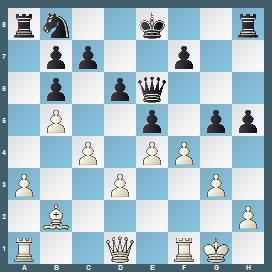
The opening of the g-file doesn't have any effect in the short term, as White's king can hide on h1, while Black king can hide on the queenside. What this is, however, is just an expansion, trying to open some files for the heavy pieces and hoping perhaps that one day, the b2 bishop will also see the light.
19...gxf4 20.gxf4 Nd7 Black finishes his development again and has not much reasons to complain about the position.
21.Kh1 Qg4 Black wants to establish some contact on the kingside, to castle queenside more safely, not to have to worry for a4–a5 play.
22.Qf3 f6 Trading queens was safe enough, with Black having a very pleasant solid position with a better pawn structure, but Carlsen is being ambitious here and at this point rightly so.
23.Qe3 0–0–0 24.f5

An interesting decision. White gets tempted with the idea to send a rook to g6, but the bishop on b2 starts look even more helpless now, with position getting further closed.
24...h4 25.Rg1 Qh5 26.Rg6 Rdg8 27.Rag1 Rxg6 28.fxg6 White initiates further changes in the position. Now he is hoping to trade the g-pawn for the h pawn, gaining a passed pawn. The problem is that he should worry about the weak d3 pawn in the process, with Nc5 coming any moment.
28...Rg8 29.g7?
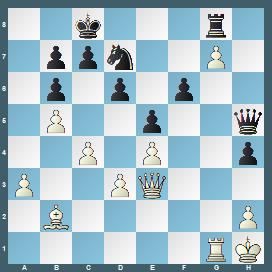
29.Qh3 was the right way to start. Now Black has a cunning option. 29...Kb8! The knight is taboo due to the Qf3+/Rg2 h3! motif. 30.Qg4 (30.Qxd7 Qf3+ 31.Rg2 h3!) 30...Qxg4 31.Rxg4 Nc5! Going for the d3 pawn. White seems to be ending up a pawn down here, but has good drawing chances once he gets some harmony, with Kg2–Kf3 and then the h-pawn running down the board.
29...Qh7? Missing a huge chance here. The g-pawn would not run away, while getting Nc5 in was huge. - 29...Kb8! This is strong. With Nc5 coming next, it is hard to see how White can avoid a collapse of his position. 30.Bc1 Nc5 31.Qh3 Qh7 is a sample line, with g7 falling, but then also the d3 pawn.; 29...Nc5! also gets the desired effect, as the tactic we had already seen works well here too- 30.d4 Ne6 31.Qh3 Kb8!
30.Qh3! Now White gets to simplify into a very manageable endgame, as he has got the passed h-pawn to compensate for the weak d3 pawn.
30...Rxg7 31.Rxg7 Qxg7 32.Qxh4 Nc5 33.Bc1
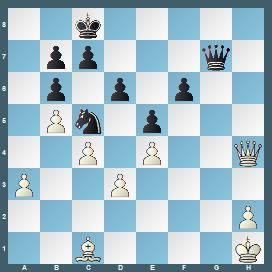
White is rearranging his forces.
33...c6 34.bxc6 bxc6 35.Qh3+ Kb7 36.Qf3 Qh7 37.Bd2 Ka6 Black is hesitating for a little bit, waiting for the right moment to initiate simplifications with b5 or d5. The position is roughly balanced at this point, and things can now go very much either way, with each side having their trumps.
38.Kg2 Qg7+ 39.Kf1 Qh7 40.h3 White chooses not to repeat moves. Not clear if this is a winning attempt, as Black also could deviate still.
40...d5

A lot of simplifications are being initiated. Draw is now the favourite.
41.Qf5 Qg8 42.cxd5 cxd5 43.exd5 Qxd5 44.Ke2 White is yet to send his h-pawn up the board and in the meantime he has to take care of the d3 pawn. I would imagine a Qg2–Qd5 repetition likely.
44...Kb5 44...Qg2+ 45.Kd1 Qd5 Maybe Carlsen wasn't sure about wanting the draw at this point, or he got confused by 46.h4!? here, either way he chooses to play differently.
45.Be3 Qg2+ 46.Bf2 Ka4
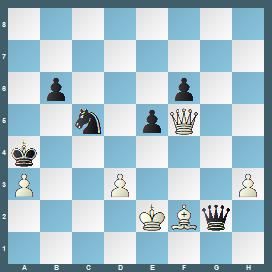
Black is still well withing the drawing margin, but he starts to drift a little bit.
47.h4 e4 48.dxe4 Nxe4 49.Qf3 Qg6 50.h5 The h-pawn starts to advance.
50...Qe8! 51.Be3?!
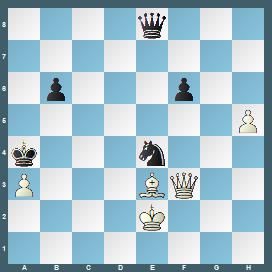
This is either a mini blunder or a draw offer, or perhaps both, as White was running short of time and draw would not be the worst of the results in this game.
51.h6! was a better try. 51...Ng5+ 52.Qe3 Qh5+ 53.Kd3 and now Black should not take on h6 because it is mate in 11 apparently, but instead keep the queen closer to the king. 53...Qd1+ amongst others, still holds at this point, though it is Black who has to now be very careful.
51...f5? A case of tactical blindness or a crazy winning attempt in the mutual time scramble.
51...Qxh5! was an elementary draw.
This is definitely the turning point in this game.
52.h6 Now black has a very hard task ahead, trying to juggle dealing with the h-pawn with the exposed king on a4. Finally Carlsen fails.
52...Qe5 53.Kf1 Qd5 54.Kg2 Qg8+ 55.Kh3 Ng5+
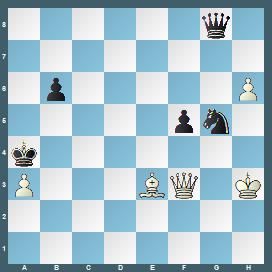
Maybe not a very practical decision. In a position as clear cut, the youngster now could calmly play for a win, knowing he will never blunder a knight fork. Also, Black may well have missed the 61.Qg7! idea, thinking this forces a draw.
55...Qg6 Keeping the status quo was maybe a more practical defensive attempt, though it's hard to say during the game.
56.Bxg5 Qxg5 57.Qc6+ Kxa3 58.Qc3+ Ka4 59.Qc4+ Ka5 60.Qc3+ Ka4 61.Qg7!
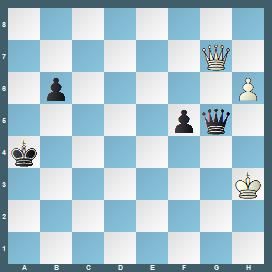
White plays for a win. It is well known that in the queen endgames, it is not about the number of pawns, but about how far is your furthest pawn that determines who is playing for a win. Here it is White, with the h-pawn being much further advanced than Black's pawns.
61...Qe3+ 62.Kh4 f4? Computer prefers direct 62...b5, not allowing the powerful idea that White executed in the game.
62...b5 63.h7 Qe4+ This is some kind of a vague perpetual. 64.Kh5 Qh1+ 65.Kg6 Qg2+ 66.Kf6 Qc6+
63.Qd7+! The move that won White the game. The direct h7 was tempting, but then Black does have a perpetual.
63.h7 Qe1+ It is not a direct perpetual, but apparently the king can't quite escape the checks.
63...b5 64.h7
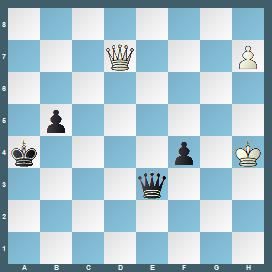
Now the the queen is not on g7 and the white king doesn't have to move in circles protecting it, there is no perpetual for Black. It becomes impossible to force a draw and just hanging in the game is a rather ungrateful task at this point, with seconds on the clock.
64...Qe5? Losing move.
65.Kg4? This is good enough to avoid the draw and keep the pressure on, but there was a very sophisticated win available at this point.
65.Qd1+!! first forcing the king to a3/b4 and only then going Qd8 apparently won. 65...Ka3 66.Qd8 Qe1+ 67.Kh5 Qe2+ 68.Kg6 Qe6+ 69.Qf6 Qe4+ (69...Qg4+ 70.Kf7 Qd7+ 71.Qe7+! this is the reason we need the king on a3/b4.) 70.Kg7 Qb7+ 71.Kg8 Qd5+ 72.Kf8 Qa8+ 73.Kf7 Qd5+ 74.Ke8 Qa8+ 75.Qd8 and now Qe4+ is met with Qe7! countercheck, while Qc6+ Kf7 Qc4+ Kg7 wins as well. 75...Qe4+ (75...Qc6+ 76.Kf7 Qc4+ 77.Kg7) 76.Qe7+; 65.Qd8 here Black is still hanging on. 65...Qe1+ 66.Kh5 Qe2+ 67.Kg6 Qe6+ 68.Qf6 Qg4+ 69.Kf7 Qh5+ 70.Kg7 Qg4+ 71.Kf8 Qc8+ 72.Kf7 Qd7+ 73.Qe7 Qd4
65...f3
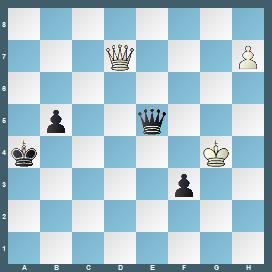
Carlsen just gives up the f-pawn, to ensure there are more checks against the king. 65...Ka3! was another defence according to the engine, but at this point it's not possible to understand what’s going on, especially in time trouble.
66.Kxf3 White's king eventually hides from checks, though that doesn't necessarily mean it's a win for him, since he also has to queen the h-pawn.
66...Qf6+ 67.Ke4 Qh4+ 68.Kd5 Qh5+ 69.Kc6 Qg6+ 70.Kc7 Qg3+ 71.Kb7 Qf3+ 72.Ka6 Qf6+ 73.Ka7 Qf2+ 74.Kb7 Qf3+ 75.Qc6 Qf7+ 76.Qc7 Qf3+ 77.Ka6 Qa8+ 78.Kb6 Finally the king hides from checks, but Black keeps on defending.
78...Qh8! White still has to queen the soldier on h7.
79.Qc2+ Ka3 80.Qd3+ Ka2 81.Kc5
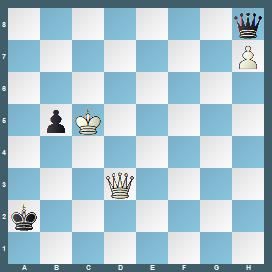
Nodirbek is being very tricky, not grabbing the pawn just yet. Now Black should try to give a perpetual and if not possible, at least not lose by force. With the pressure being this high for this long and with the clock ticking, Carlsen finally collapses.
81...b4? There is no point doing this. Black had to start checking. The position would objectively still be a draw, though in reality it's a very hard task to defend this.
82.Qd2+ Ka1?? Although the computer already points out that White is winning, I believe the win is not obvious if Black wouldn't blunder a queen trade. This move loses the game.
83.Qd4+! What a fight! 1–0
*******************************************************************
NEW: ChessBase Magazine Extra #206
Opening videos
Robert Ris: Hennig-Schara Gambit
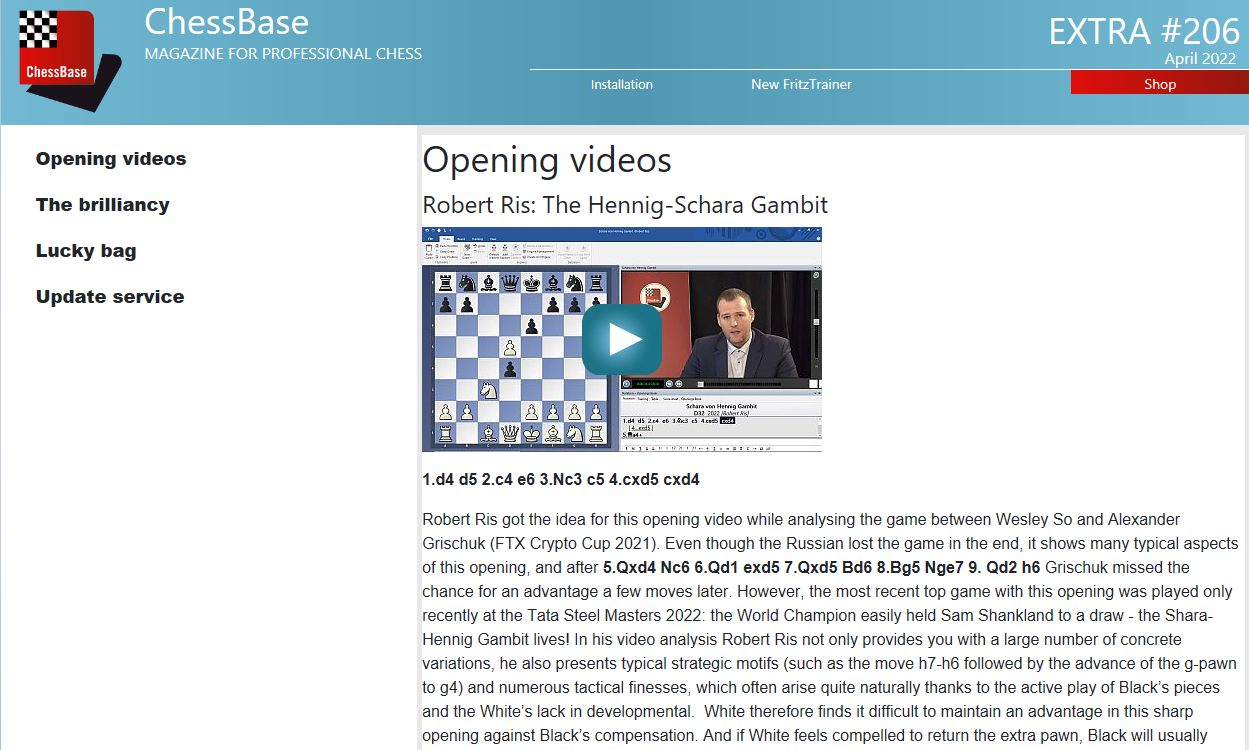
1.d4 d5 2.c4 e6 3.Nc3 c5 4.cxd5 cxd4 – Video playing time : 33:59 min.
Robert Ris got the idea for this opening video while analysing the game between Wesley So and Alexander Grischuk (FTX Crypto Cup 2021). Even though the Russian lost the game in the end, it shows many typical aspects of this opening, and after 5.Qxd4 Nc6 6.Qd1 exd5 7.Qxd5 Bd6 8.Bg5 Nge7 9. Qd2 h6 Grischuk missed the chance for an advantage a few moves later. However, the most recent top game with this opening was played only recently at the Tata Steel Masters 2022: the World Champion easily held Sam Shankland to a draw - the Hennig-Schara Gambit lives!
In his video analysis Robert Ris not only provides you with a large number of concrete variations, he also presents typical strategic motifs (such as the move h7-h6 followed by the advance of the g-pawn to g4) and numerous tactical finesses, which often arise quite naturally thanks to the active play of Black’s pieces and the White’s lack in developmental. White therefore finds it difficult to maintain an advantage in this sharp opening against Black’s compensation. And if White feels compelled to return the extra pawn, Black will usually keep active play and often the initiative. "A lot of strong White players have gone wrong in the opening or even in an early middlegame. Just try it out in one of your own games and you will understand what sort of compensation Black is aiming for!"
Mihail Marin: The Fianchetto System against Gruenfeld and the King's Indian
.jpg)
1.d4 Nf6 2.c4 g6 3.Nf3 Bg7 4.g3 0-0 5.Bg2 c6 6.0-0 d5 7.b3 Bf5 8.Bb2 – Vidoe playing time: 22:04 min.
The game between Magnus Carlsen and Jorden van Foreest at the Tata Steel 2022 saw a sharp battle, with the young Dutchman sacrificing two pawns and being rewarded with a draw in the end. At the start of the game the World Champion with White had chosen the Fianchetto System - a setup which Mihail Marin made his main weapon against the Gruenfeld and the King's Indian a good 30 years ago. In his video he explains - with recourse to games by Predrag Nikolic and other games by Carlsen and Van Foreest - the strategic ideas for both sides as well as typical plans (for White, for example, the move sequence Qd1-e2, Rf1-c1, Bg2-f1, followed by the advance of the queenside pawns). "The system is quite consistent for White. It can be played endlessly. Of course it does not guarantee that White will win but it offers him very good chances for a stable advantage and he can just play in a flowing way."
"The brilliancy” of this issue is the game between Nodirbek Abdusattorov and Magnus Carlsen from the 2021 World Rapid Chess Championship - analysed by Anish Giri! A great fighting game in which the 17-year-old Uzbek downed the World Champion in 83 moves. And a few rounds later Abdusattorov was crowned the youngest ever world rapid chess champion!
In addition to “The brilliancy”, no less than 83 other games with detailed commentary await you in the "Lucky Bag" of this issue! Among them are analyses by Nijat Abasov, Romain Edouard, Anish Giri, Spyridon Kapnisi, Marie Sebag, Andrey Stukpoin and many others.
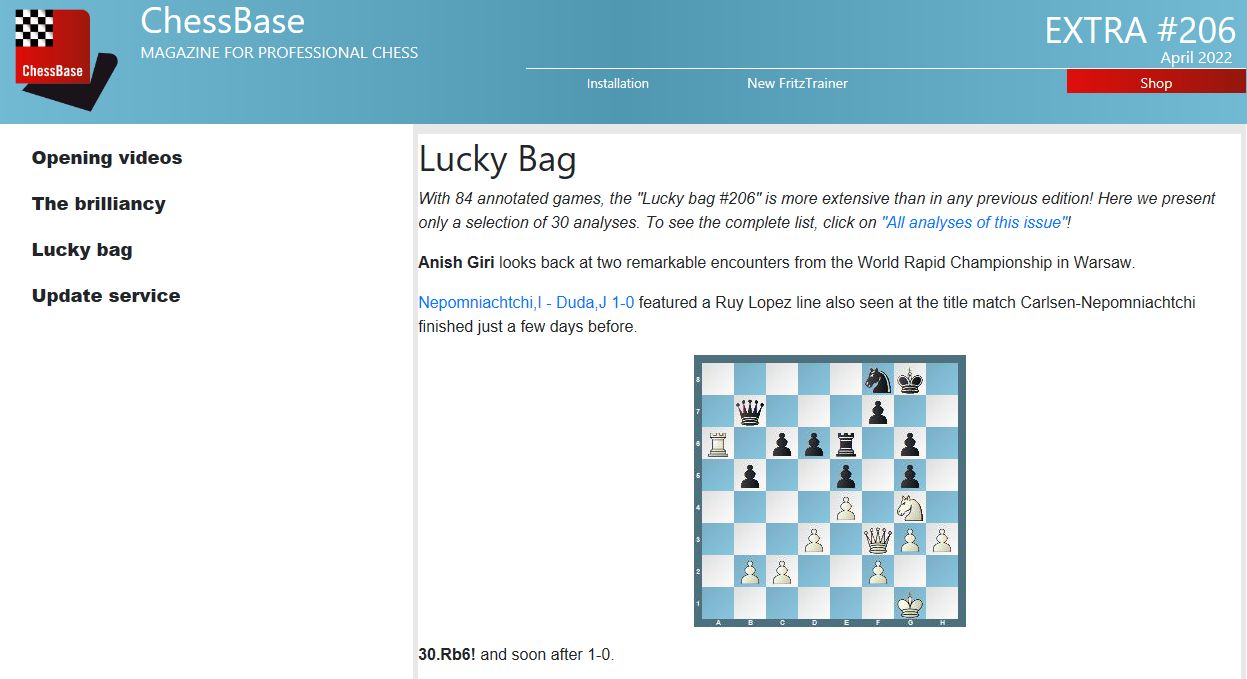
And last but not least: the Update service provides over 30,000 new games for your database!
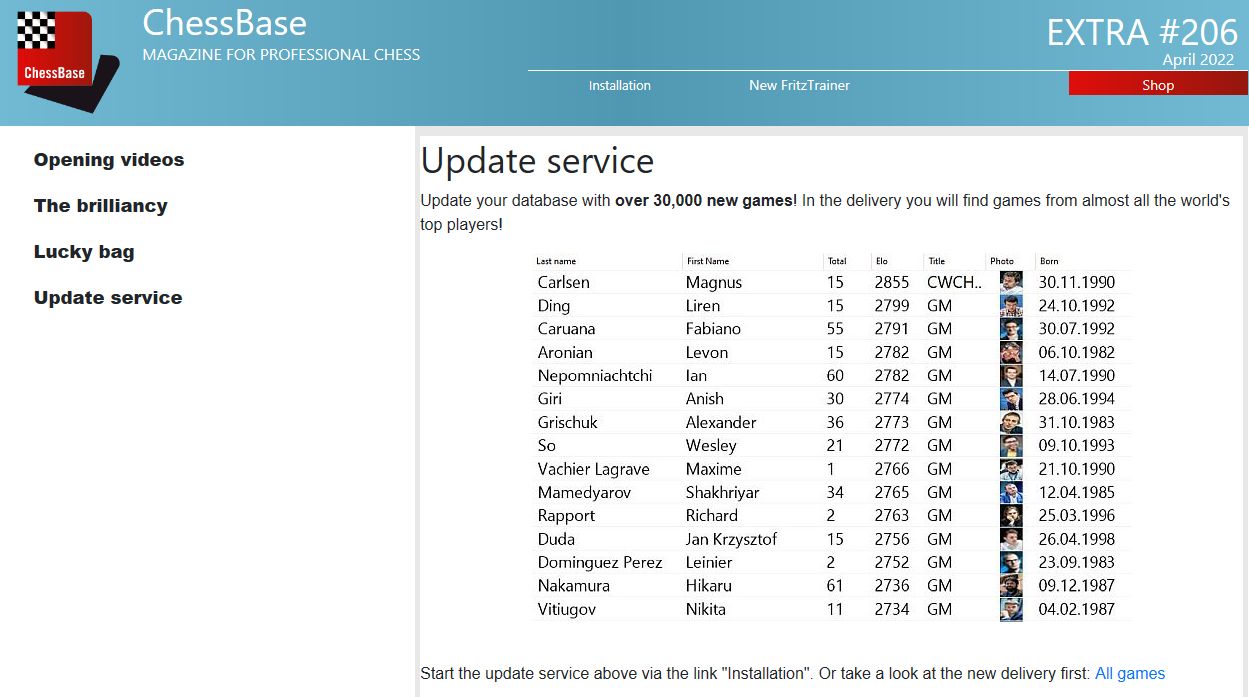
Once again, almost the entire world's top players are represented!
The games of the Update Service are also included in the Mega Update Service 2022, which you can use with a ChessBase 15/16 program (and a corresponding subscription).


































.jpg)







